Abstract
We evaluated the effect of the inhalant anesthetic isoflurane and the injectable combination of anesthetics ketamine/inactin on cardiac function by measuring left ventricular (LV) pressure in situ during control conditions and during β-adrenergic stimulation with isoproterenol (ISO). The control heart rate (HR) and the maximal rate of contraction were significantly higher in the isoflurane group, but there was no difference in the rate of relaxation. During the ISO (0.32 ng · g body wt–1· min–1) stimulation the developed pressure (DP) increased 9.8 ± 1.8% (n = 11) in the ketamine/inactin group and was unchanged in the isoflurane group. The HR increased 28.4 ± 4.8% (n = 11) in the ketamine/inactin group and only 3.4 ± 0.6% (n = 11) in the isoflurane group. The rate of contraction increased 103.2 ± 9.3% (n = 11) and 13.6 ± 4.6% (n = 11) in the ketamine/inactin and isoflurane groups, respectively. At this dose of ISO the rate of relaxation did not change significantly. In control conditions there was no difference in levels of cAMP between the groups (2.29 ± 0.25 pmol/mg protein (n = 5) in the ketamine/inactin group and 2.79 ± 0.35 pmol/mg protein (n = 6) in the isoflurane group). However, during the ISO stimulation the cAMP level increased only in the ketamine/ inactin group of animals (3.50 ± 0.30 pmol/mg protein; n = 5). This level was significantly higher than the level in the isoflurane group stimulated with ISO (2.22 ± 0.30 pmol/mg protein; n = 6). In summary, our results indicate that the anesthetics differ significantly in the extent of depression of the basal and β-adrenergic stimulated state with the second messenger cAMP playing a prominent role.
Similar content being viewed by others
References
Arras M, Autenried P, Rettich A, Spaeni D, Rulicke T (2001) Optimization of intraperitoneal injection anesthesia in mice: drugs, dosages, adverse effects, and anesthesia depth. Comp Med 51:443–456
Chu V, Otero JM, Lopez O, Morgan JP, Amende I, Hampton TG (2001) Method for non-invasively recording electrocardiograms in conscious mice. BMC Physiol 1:6
Desai KH, Sato R, Schauble E, Barsh GS, Kobilka BK, Bernstein D (1997) Cardiovascular indexes in the mouse at rest and with exercise: new tools to study models of cardiac disease. Am J Physiol 272:H1053–H1061
Evans CC, Pena JR, Phillips RM, Muthuchamy M, Wieczorek DF, Solaro RJ, Wolska BM (2000) Altered hemodynamics in transgenic mice harboring mutant tropomyosin linked to hypertrophic cardiomyopathy. Am J Physiol 279:H2414–H2423
Fentzke RC, Buck SH, Patel JR, Lin H, Wolska BM, Stojanovic MO, Martin AF, Solaro RJ, Moss RL, Leiden JM (1999) Impaired cardiomyocyte relaxation and diastolic function in transgenic mice expressing slow skeletal troponin I in the heart. J Physiol 517:143–157
Frazer MJ, Lynch C (1992) Halothane and iso.urane effects on Ca2+ fluxes of isolated myocardial sarcoplasmic reticulum. Anesthesiology 77:316–323
Gamo S (2002) Studies on target genes of general anesthetics. Curr Drug Targets 3:31–41
Hart CY, Burnett JC Jr, Redfield MM (2001) Effects of avertin versus xylazine- ketamine anesthesia on cardiac function in normal mice. Am J Physiol 281:H1938–H1945
Hoit BD, Ball N, Walsh RA (1997) Invasive hemodynamics and forcefrequency relationships in open-versus closed-chest mice. Am J Physiol 273:H2528–H2533
Humphrey JA, Sedensky MM, Morgan PG (2002) Understanding anesthesia: making genetic sense of the absence of senses. Hum Mol Genet 11:1241–1249
Ishii K, Kuwahara M, Tsubone H, Sugano S (1996) Autonomic nervous function in mice and voles (Microtus arvalis): investigation by power spectral analysis of heart rate variability. Lab Anim 30:359–364
Janssen BJ, Smits JF (2002) Autonomic control of blood pressure in mice: basic physiology and effects of genetic modification. Am J Physiol 282:R1545–R1564
Jiang Y, Julian FJ (1998) Effects of isoflurane on [Ca2+]i, SR Ca2+ content, and twitch force in intact trabeculae. Am J Physiol 275:H1360–H1369
Just A, Faulhaber J, Ehmke H (2000) Autonomic cardiovascular control in conscious mice. Am J Physiol 279:R2214–R2221
Kass DA, Hare JM, Georgakopoulos D (1998) Murine cardiac function: a cautionary tail. Circ Res 82:519–522
Lorenz JN (2002) A practical guide to evaluating cardiovascular, renal, and pulmonary function in mice. Am J Physiol 282:R1565–R1582
Lorenz JN, Robbins J (1997) Measurement of intraventricular pressure and cardiac performance in the intact closedchest anesthetized mouse. Am J Physiol 41:H1137–H1146
Palakodeti V, Oh S, Oh BH, Mao L, Hongo M, Peterson KL, Ross JJ (1997) Force-frequency effect is a powerful determinant of myocardial contractility in the mouse. Am J Physiol 273:H1283–H1290
Park KW, Dai HB, Lowenstein E, Darvish A, Sellke FW (1995) Isoflurane attenuates cAMP-mediated vasodilation in rat microvessels. Circulation 92:II423–II427
Pentyala S, Moller D, Chowdhury A, Sung KY, Rebecchi M (1998) Effects of inhalational anesthetics on α2-adrenergic signaling in isolated platelets. Toxicol Lett 100–101:115–120
Roth DM, Swaney JS, Dalton ND, Gilpin EA, Ross J Jr (2002) Impact of anesthesia on cardiac function during echocardiography in mice. Am J Physiol 282:H2134–H2140
Schotten U, Schumacher C, Sigmund M, Karlein C, Rose H, Kammermeier H, Sivarajan M, Hanrath P (1998) Halothane, but not isoflurane, impairs the beta-adrenergic responsiveness in rat myocardium. Anesthesiology 88:1330–1339
Shusterman V, Usiene I, Harrigal C, Lee JS, Kubota T, Feldman AM, London B (2002) Strain-specific patterns of autonomic nervous system activity and heart failure susceptibility in mice. Am J Physiol 282:H2076–H2083
Slater SJ, Cox KJ, Lombardi JV, Ho C, Kelly MB, Rubin E, Stubbs CD (1993) Inhibition of protein kinase C by alcohols and anaesthetics. Nature 364:82–84
Takuma S, Suehiro K, Cardinale C, Hozumi T, Yano H, Shimizu J, Mullis-Jansson S, Sciacca R, Wang J, Burkhoff D, Di Tullio MR, Homma S (2001) Anesthetic inhibition in ischemic and nonischemic murine heart: comparison with conscious echocardiographic approach. Am J Physiol 280:H2364–H2370
Tanaka S, Tsuchida H (1998) Effects of halothane and isoflurane on β-adrenoceptor-mediated responses in the vascular smooth muscle of rat aorta. Anesthesiology 89:1209–1217
Uechi M, Asai K, Osaka M, Smith A, Sato N, Wagner TE, Ishikawa Y, Hayakawa H, Vatner DE, Shannon RP, Homcy CJ, Vatner SF (1998) Depressed heart rate variability and arterial baroreflex in conscious transgenic mice with overexpression of cardiac Gsa. Circ Res 82:416–423
Zuurbier CJ, Emons VM, Ince C (2002) Hemodynamics of anesthetized ventilated mouse models: aspects of anesthetics, fluid support, and strain. Am J Physiol 282:H2099–H2105
Author information
Authors and Affiliations
Corresponding author
Rights and permissions
About this article
Cite this article
Peña, J.R., Wolska, B.M. Differential effects of isoflurane and ketamine/inactin anesthesia on cAMP and cardiac function in FVB/N mice during basal state and β–adrenergic stimulation. Basic Res Cardiol 100, 147–153 (2005). https://doi.org/10.1007/s00395-004-0503-6
Received:
Revised:
Accepted:
Published:
Issue Date:
DOI: https://doi.org/10.1007/s00395-004-0503-6




